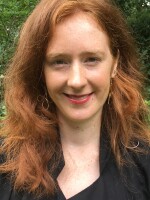For months, families across New Hampshire have been wondering what school would look like. And now, a lot of them have a first taste. There have been technological glitches and reports of positive coronavirus cases in several districts.
But as NHPR’s Sarah Gibson reports, many people say they’re relieved the new school year has finally begun.
Get the latest on COVID and schools in your inbox: Sign up for our newsletter today.
Thursday was the first day of school for Westmoreland Elementary School principal Mark Hayward, and it started early.

“I woke up at 3:30, kind of like ‘Ah!,’ and I was actually thinking about the bus pick-up today,” he says.
Hayward donned an outfit to celebrate the school’s bulldog mascot - a blue bulldog belt, shorts embroidered with bulldogs, the school’s signature blue polo shirt - and headed to school.
Westmoreland, a small town near Keene, is starting the year with a hybrid model; most students are in the building two days a week and home for the rest.
As the school day began, Hayward wondered how parents would manage the new COVID-19 screening survey and remember when to get their kids on the bus.
“You might have a kid at this school and a kid at the high school,” he says. “You can imagine: you’re getting their lunch ready, you’re getting your kid ready for school. Do they have what they need in their backpack? Is this the right day? And then you think: ‘I gotta do the screening.’ It’s overwhelming. People’s heads are about to explode.”

Hayward says despite the complications, the town has come together - donating picnic tables for outdoor classrooms, researching deals on plastic barriers for desks, and prepping kids for how to stay safe.
When students finally arrived, Hayward asked them what the most important thing was to remember this year. Hands shot up.
“They were like, ‘Make sure you wear your masks!’” he smiles. “Elementary kids were like: ‘6 feet apart and washing your hands!’”
Hayward kept a list of problems to troubleshoot, but by the end of day one, he felt a weight lift off his shoulders.
“There’s a lot I’ve been thinking about in the middle of the night all summer,” he says. “When it finally happens, it’s a huge relief.”
But not all districts are bringing classes back into the building. Some of the state's largest school districts are sticking with a remote model at least until October.
In Somersworth, most students log onto Google Classroom each day from home.
“It’s hard being home by myself and without any help,” says 10th grader Maggie Lanoue. Lanoue feels safer learning from home, but she’s still getting used to the isolation of remote school.

She and her mom have brainstormed ways to cope: baking, visiting family members, giving her dog a bath, and staying in touch with her best friend and classmate Kayah Gautreau.
“If I'm in a really bad mood or something, I'll call or Facetime her,” Lanoue explains. “And she just listens to me yell for a good five minutes and then she yells if she needs to. And then we just talk to each other, see how we're doing, and calm down with each other.”
Kayah Gautreau is dealing with another challenge of remote learning: bad internet. This means she can’t always participate in class or turn work in on time.
"I’ll email teachers; I'll call them; I'll text them; I'll send through Google Classroom, like 'Hey, I can't get these assignments in,'" she says. "And half the time they won't respond because those messages won't go through."
Gautreau has developed new strategies to get through, including asking friends to communicate on her behalf, or going to Maggie's house for internet.
The friends say remote learning in the spring was so haphazard that many students tuned out, but this year, they’re pleasantly surprised by their teachers’ level of communication and understanding, and their classmates’ high attendance.
“Truthfully, I was surprised at the fact that everyone is there every day,” says Lanoue.

Attendance is one of the many things districts are using to measure their success in reopening. One of the others is how students with special education needs get adequate services.
Mary Ellen Biser is raising her five grandchildren in Bedford. All of them need special education services, which she found out in the spring are nearly impossible to provide at home.
“Even though [the district] tried hard by doing it on a Chromebook, you can't help a kid with occupational therapy and physical therapy on a Chromebook,” she says. “I’m too old to be sitting there babysitting them at a table.”
After meeting with administrators and teachers this summer, Biser’s family decided it was worth the health risk to send all five kids back to school. She is still learning to juggle different hybrid schedules, which administrators are tweaking to accommodate all the special ed services Biser’s grandchildren are entitled to by law.
Biser says at least some of her grandkids are “thrilled” to be back in school.
On Friday, all of them went into the building, giving 74-year old Biser her first day alone since schools went remote last March.
“There are other things in my life that I have to do during the week, and I have not been able to do that since March 17th,” she says. “I need to have at least one to two days a week…for me.”
First on Biser’s Friday agenda: morning coffee with an old friend, and a pedicure.
Read more of NHPR's COVID & The Classroom series here. If you have a tip or a story idea, please email it to: education@nhpr.org









